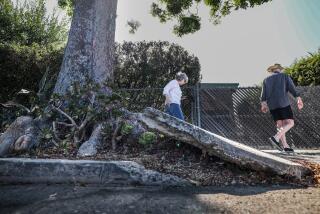Graffiti Vandal Given Jail Term, $34,000 Fine
- Share via
In one of the stiffest graffiti penalties meted out in Los Angeles County courts, a Calabasas high school student was sentenced Monday to nine months in jail and ordered to pay $34,000 in restitution for tagging along the Ventura Freeway in Sherman Oaks.
John Azim Lake, 19, a student at Indian Hills High School, also was placed on three years probation and ordered to perform 100 hours of graffiti cleanup after pleading guilty to felony vandalism as part of a plea bargain.
The sentence drew immediate praise from community leaders--particularly the $34,000 that Lake was ordered to pay by Van Nuys Municipal Judge Leslie Dunn.
“Hopefully, this will do two things,” said Richard Close, president of the Sherman Oaks Homeowners Assn. “One, it will discourage taggers from doing this. Two, it will shift the cost from the city to the culprit.”
The city of Los Angeles spends more than $4 million annually to eradicate graffiti.
“Right now, it’s mostly city money being spent on the cleanup, which diverts money away from hiring police officers,” Close said.
Eric Rose, a spokesman for Los Angeles City Councilwoman Laura Chick, said the sentence was “in line with what Laura believes--that you have to hold graffiti vandals responsible for their actions.”
Added Ardean Smith, 75, a member of the Panorama City Graffiti Busters, a volunteer group that spends weekends washing walls: “I think it’s a good idea. He probably should pay a little more.”
Deputy Dist. Atty. James Bozajian, the prosecutor in the case, said Lake was arrested after an investigation that began earlier this year when a witness notified authorities of graffiti along the Ventura Freeway.
Ultimately, Bozajian said, Lake was connected to at least 28 incidents of graffiti between April, 1994, and March, 1995, with an estimated damage of $34,000.
If Lake had been convicted at a trial, he faced up to three years in prison, Bozajian said.
*
He added that the plea bargain was appropriate because Lake was ordered to pay the cost of cleaning up his scrawlings and will have to clean up other graffiti.
If Lake fails to make a good effort to pay the restitution within three years, his probation will be extended for two years, the prosecutor said.
Graffiti cases are usually prosecuted as misdemeanors--not more serious felonies--because they typically involve single incidents with damage of less than several hundred dollars, Deputy City Atty. Richard A. Schmidt said.
Cases involving damages of more than $5,000 can be prosecuted as felonies, where the maximum sentence is the three-year state prison term.
Schmidt said first-time misdemeanor vandalism offenders are usually sentenced to graffiti removal with no jail time. However, second-time offenders are usually sentenced to some time in jail in addition to the graffiti cleanup. The jail time can range from 10 to 180 days, he said.
Lake has been in custody since his arrest April 11.
Prosecutors decide to file felonies on a case-by-case basis, Bozajian said. “You generally don’t get that many adults because most people outgrow that kind of behavior,” he said.
But in the Lake case, he added, there was “clearly a need to do something,” noting that “there is a general outrage in the community at this kind of behavior.”
More to Read
Sign up for Essential California
The most important California stories and recommendations in your inbox every morning.
You may occasionally receive promotional content from the Los Angeles Times.










